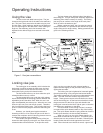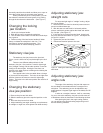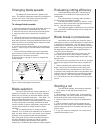
14
Maintenance
Replacing blades
1. Disconnect the saw from its electrical power source to
prevent accidental start-ups.
2. Raise the saw arm to its full vertical position and lock it
in place using the quick shut off valve on the hydraulic
control cylinder.
3. Lift the safety cover in the lower portion of the blade
guard door by sliding it upward. There is no need to
remove it completely from its slot.
4. Remove the two screws with plastic knobs which hold
the blade guard door closed and swing the door open to
expose the drive and idler wheels, and the blade.
5. Turn the blade tension handle counterclockwise until
the blade hangs loose in the saw arm.
6. Use leather gloves to prevent cuts and scratches and
use protective eyewear which meets ANSI Specification
Z87.1. and pull the blade off of the drive wheels and out of
the blade guides. Store the blade carefully before
proceeding.
7. Slide the new blade into the blade guides -- then loop
the blade over the upper and lower drive wheels.
Note: it is possible to install the blade backwards. The
teeth on the blade should be pointing downward, toward
the motor, at the time the blade is installed.
8. Push the blade so it is seated against the shoulders of
the wheels. When it is seated against the shoulders...
9. ...turn the blade tension wheel clockwise to increase
tension on the blade. Don't over-tension the blade.
Tension it enough so it doesn't slip while cutting.
10. When you are satisfied that the saw is tensioned
correctly, reconnect the saw to its electrical power source.
11. Check the tracking of the blade according to
instructions in the section on Adjusting blade tracking,
below.
12. Close the wheel guard door and secure it using the
two plastic knobbed screws.
13. Slide the safety cover downward in its slot until it is
fully closed.
14. The new blade is installed and ready for the Blade
break-in procedures.
Adjusting blade tracking
If the blade is fully tensioned, release tension
slightly before attempting to adjust the saw blade tracking.
A badly worn or bent blade will be extremely difficult to
track properly -- if it can be tracked successfully, at all.
The track of the saw blade is adjusted using the track
adjustment mechanism on the idler wheel. The track
adjustment tilts the wheel to "steer" the blade on the
wheels. Tracking adjustment is performed with the saw
arm in vertical position, blade guard doors open and the
saw running. Therefore, USE EXTREME CAUTION
WHEN PERFORMING BLADE TRACKING CHECKS AND
ADJUSTMENTS.
To adjust blade tracking:
1. Loosen the sliding plate draw block bolt slightly so the
adjustment set screw will be able to move the draw block.
2. Turn the coolant pump switch OFF, if coolant is used.
3. Turn the saw ON.
4. Insert a 4mm hex wrench in the socket head track
adjustment set screw.
5. Turn the track adjustment set screw so the blade starts
to move away from the shoulder -- then immediately turn
the screw the other direction so the blade stops -- then
moves slowly toward the shoulder.
6. Use the blade tracking adjustment screw to stop the
motion of the blade on the wheel as it gets close to the
shoulder. Now, put a strip of paper between the blade and
wheel as shown in Figure 9. KEEP FINGERS CLEAR OF
THE BLADE AND WHEEL. (That's why the paper strip
should be at least 6 inches long.)
7. The paper should not be cut, this first attempt. Next,
turn the track adjustment set screw a tiny amount more
and repeat the insertion of the paper between the blade
and wheel.
You may have to repeat this step several times before the
blade and shoulder cut the paper into two pieces. Don't
be in a hurry. Patience and accuracy here will pay off with
better, more accurate, quieter cutting and much longer
machine and blade life.
8. When the paper is cut, turn the adjustment screw
counterclockwise, slightly. This assures that the blade is
not touching the shoulder of the wheel.
9. Tighten the two bolts which hold the draw block.
Figure 9: Inserting the paper strips between the blade
and wheel to adjust blade-to-shoulder clearance


















